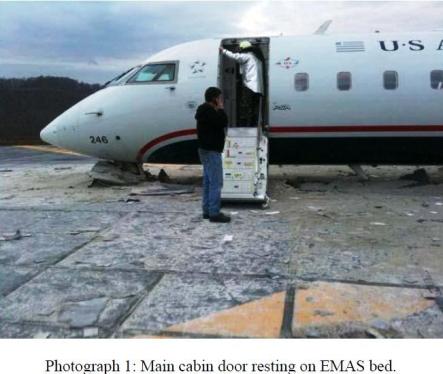Interviews, cockpit voice recorder transcripts and flight recorder data released by the US National Transportation Safety Board (NTSB) today reveal numerous breaches of standard procedures by the flight crew in the overrun of a PSA Airlines Bombardier CRJ200 in Charleston, West Virginia on 19 January.
None of the 31 passengers or three crewmembers were injured when US Airways Express Flight 2495 exited the runway and came to rest 39m (128ft) into a 123m engineered material arresting system (EMAS) bed at the end or Runway 23 after a high-speed rejected take off (RTO).
 |
|---|
©NTSB |
Newly released interviews of the pilots and transcripts of the cockpit voice recorder shows multiple procedural errors by captain, also a check pilot for PSA, and the first officer.
After leaving the gate, the pilots had been discussing personal information, contrary to PSA's rules, which require a "sterile cockpit" during all ground operation "involving taxi, takeoff and landing" and all other flight operations below 10,000ft (3,048m).
During that time, the first officer also failed to set the aircraft's flaps to the 20 degree setting as part of the taxi checklist, a setting called out in PSA procedures for takeoff from Charleston's Yeager airport, but rather set the flaps to 8 degrees. The captain, who was to perform the takeoff, did not verify the setting, missing the error.
During the takeoff run, the captain recalled noticing at about 80kt (148km/h) speed, called out by the first officer, that the flaps were incorrect.
He told investigators he reached down to set the lever to the 20 degree setting. Once the flaps began moving, flap and slat configuration alerts sounded in the cockpit.
The captain told investigators "the flaps not being set correctly would have been reason to abort the takeoff" at 80kt, the speed below which PSA says to abort a takeoff for "any malfunction". The captain further stated that "he did not know why he did not call for the abort" at that point.
Matching FDR time tags with the CVR information reveals that the captain commanded the higher flap setting at a speed greater than 100kt. The aircraft continued to accelerate, with the first officer calling out "V1" at approximately 130kt airspeed.
Shortly after the V1 call, the configuration warnings went off. The airspeed continued to increase to approximately 143kt before the captain reduced power and attempted to stop. PSA rules call for an abort above 80kt for engine failures, fire warnings, loss of directional control or if "the aircraft is considered unsafe to fly", according to the NTSB.
Though PSA rules call for full reverse thrust in an RTO, the captain stated that he might not have pulled the thrust levers "all the way back to idle" during the abort process, a required step to initiate reverse thrust. The first officer did not make speed callouts during the RTO, as required by PSA procedures.
The NTSB did not provide any analysis of the data released today and has not yet set a date for a final report on the incident.
PSA is an Ohio-based regional subsidiary of US Airways operating a fleet of CRJ200s and CRJ700s. The CRJ200 involved in the Charleston incident, registered as N246PS, was manufactured in 2004 and is owned by GECAS, according to the ACAS database.
Source: Air Transport Intelligence news



















